- Joined
- Oct 9, 2007
- Messages
- 47,404 (7.52/day)
- Location
- Hyderabad, India
| System Name | RBMK-1000 |
|---|---|
| Processor | AMD Ryzen 7 5700G |
| Motherboard | ASUS ROG Strix B450-E Gaming |
| Cooling | DeepCool Gammax L240 V2 |
| Memory | 2x 8GB G.Skill Sniper X |
| Video Card(s) | Palit GeForce RTX 2080 SUPER GameRock |
| Storage | Western Digital Black NVMe 512GB |
| Display(s) | BenQ 1440p 60 Hz 27-inch |
| Case | Corsair Carbide 100R |
| Audio Device(s) | ASUS SupremeFX S1220A |
| Power Supply | Cooler Master MWE Gold 650W |
| Mouse | ASUS ROG Strix Impact |
| Keyboard | Gamdias Hermes E2 |
| Software | Windows 11 Pro |
Here they are, boxes that carry AMD's first desktop six-core processors, the Phenom II X6. This line of "true six core design" processors from AMD target performance/price sweet-spots in the sub-$300 segment, targeting higher-end Intel Core i5, and even Core i7 series processors from Intel. The Phenom II X6 is based on the 45 nm "Thuban" core, and comes in the socket AM3 package. The processor is said to be backwards-compatible with socket AM2+ on motherboards with a BIOS update. Expreview sourced pictures of three Phenom II X6 processor-in-box (PIB) units, of model 1055T.
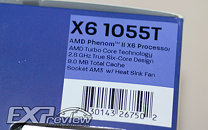


Apart from a numerical boost in processor cores over the Phenom II X4, the Phenom II X6 brings in a landmark new feature for AMD, the Turbo Core technology. This new feature senses load on each of the processor cores, and adjusts each individual core's power-states and frequencies accordingly. Unlike with the comparable Intel Turbo Boost technology, AMD's Turbo Core tech gives the processor higher number of "Turbo" cores when the multi-threaded load is low. Turbo Boost does not require any special software to work, not even new drivers for any given OS. All its logic is embedded on-die.
Sensing low multi-threaded power load, Turbo Core powers down three of the six cores, while sending the three remaining cores into a "Boost state". In this state, the cores' clock-speed is boosted by up to 500 MHz (multiplier +2.5x). Throughout the Boost state, the processor stays within the processor's defined TDP. The processor leaves Boost state when it senses more multi-threaded power is needed. Following are slides from AMD's press-briefing where it specifically talked about Turbo Core:
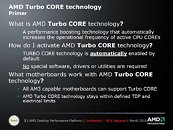
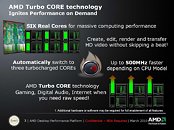
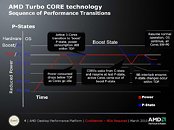
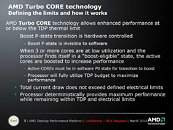
Apart from Phenom II X6, Turbo Core technology will also be featured on Phenom II X4 900T "Zosma" series quad-core processors. These chips will offer two Boost-state cores.
View at TechPowerUp Main Site



Apart from a numerical boost in processor cores over the Phenom II X4, the Phenom II X6 brings in a landmark new feature for AMD, the Turbo Core technology. This new feature senses load on each of the processor cores, and adjusts each individual core's power-states and frequencies accordingly. Unlike with the comparable Intel Turbo Boost technology, AMD's Turbo Core tech gives the processor higher number of "Turbo" cores when the multi-threaded load is low. Turbo Boost does not require any special software to work, not even new drivers for any given OS. All its logic is embedded on-die.
Sensing low multi-threaded power load, Turbo Core powers down three of the six cores, while sending the three remaining cores into a "Boost state". In this state, the cores' clock-speed is boosted by up to 500 MHz (multiplier +2.5x). Throughout the Boost state, the processor stays within the processor's defined TDP. The processor leaves Boost state when it senses more multi-threaded power is needed. Following are slides from AMD's press-briefing where it specifically talked about Turbo Core:




Apart from Phenom II X6, Turbo Core technology will also be featured on Phenom II X4 900T "Zosma" series quad-core processors. These chips will offer two Boost-state cores.
View at TechPowerUp Main Site










 same as steam, but thats a different story
same as steam, but thats a different story 
 Hopefully they pull through for my motherboard!
Hopefully they pull through for my motherboard!